MGN442 Assessment 1: Literature Review on Self-Leadership in Sales
VerifiedAdded on 2021/06/02
|9
|2891
|204
Report
AI Summary
This report provides a literature review focusing on the impact of thought self-leadership on work performance, particularly within the sales environment. It begins by defining self-leadership and its core components, emphasizing constructive thought patterns. The report then examines three key studies: Neck & Manz (1996), Panagopoulos & Ogilvie (2015), and Singh, Kumar & Puri (2017), comparing their methodologies, findings, and limitations. The Neck & Manz (1996) study, a training intervention, is critiqued for its design flaws, while the latter two studies, using non-experimental designs, are praised for their larger and more diverse samples. The review highlights the positive relationship between thought self-leadership, self-efficacy, and job performance, as observed across all three studies. The report concludes by suggesting areas for future research, including experimental designs, longitudinal studies, and the investigation of cultural influences, to further enhance the understanding of self-leadership's impact. The report emphasizes the relevance of self-leadership in modern sales, where self-management is crucial.

MGN442 Assessment 1 - Literature Review
Paraphrase This Document
Need a fresh take? Get an instant paraphrase of this document with our AI Paraphraser
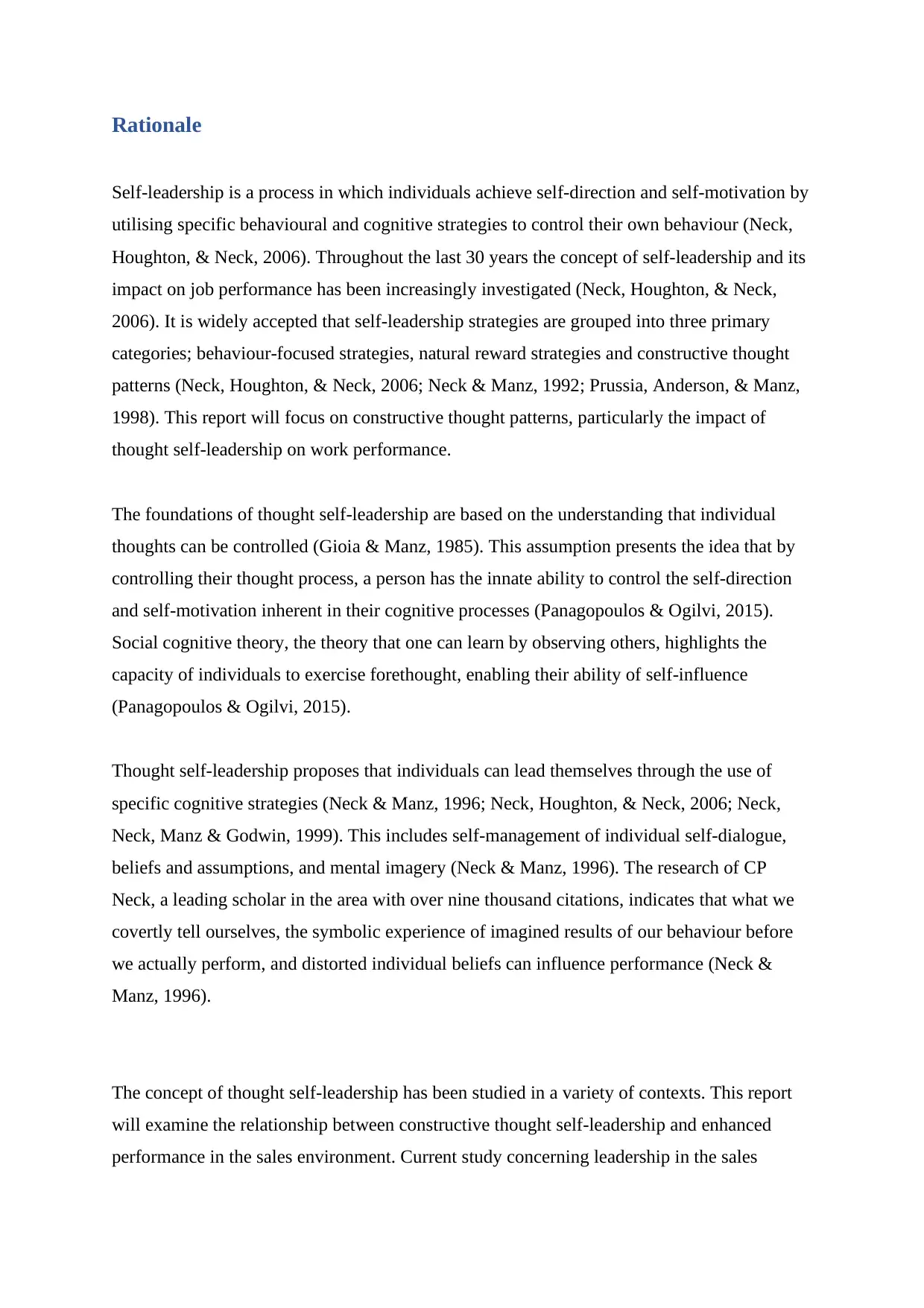
Rationale
Self-leadership is a process in which individuals achieve self-direction and self-motivation by
utilising specific behavioural and cognitive strategies to control their own behaviour (Neck,
Houghton, & Neck, 2006). Throughout the last 30 years the concept of self-leadership and its
impact on job performance has been increasingly investigated (Neck, Houghton, & Neck,
2006). It is widely accepted that self-leadership strategies are grouped into three primary
categories; behaviour-focused strategies, natural reward strategies and constructive thought
patterns (Neck, Houghton, & Neck, 2006; Neck & Manz, 1992; Prussia, Anderson, & Manz,
1998). This report will focus on constructive thought patterns, particularly the impact of
thought self-leadership on work performance.
The foundations of thought self-leadership are based on the understanding that individual
thoughts can be controlled (Gioia & Manz, 1985). This assumption presents the idea that by
controlling their thought process, a person has the innate ability to control the self-direction
and self-motivation inherent in their cognitive processes (Panagopoulos & Ogilvi, 2015).
Social cognitive theory, the theory that one can learn by observing others, highlights the
capacity of individuals to exercise forethought, enabling their ability of self-influence
(Panagopoulos & Ogilvi, 2015).
Thought self-leadership proposes that individuals can lead themselves through the use of
specific cognitive strategies (Neck & Manz, 1996; Neck, Houghton, & Neck, 2006; Neck,
Neck, Manz & Godwin, 1999). This includes self-management of individual self-dialogue,
beliefs and assumptions, and mental imagery (Neck & Manz, 1996). The research of CP
Neck, a leading scholar in the area with over nine thousand citations, indicates that what we
covertly tell ourselves, the symbolic experience of imagined results of our behaviour before
we actually perform, and distorted individual beliefs can influence performance (Neck &
Manz, 1996).
The concept of thought self-leadership has been studied in a variety of contexts. This report
will examine the relationship between constructive thought self-leadership and enhanced
performance in the sales environment. Current study concerning leadership in the sales
Self-leadership is a process in which individuals achieve self-direction and self-motivation by
utilising specific behavioural and cognitive strategies to control their own behaviour (Neck,
Houghton, & Neck, 2006). Throughout the last 30 years the concept of self-leadership and its
impact on job performance has been increasingly investigated (Neck, Houghton, & Neck,
2006). It is widely accepted that self-leadership strategies are grouped into three primary
categories; behaviour-focused strategies, natural reward strategies and constructive thought
patterns (Neck, Houghton, & Neck, 2006; Neck & Manz, 1992; Prussia, Anderson, & Manz,
1998). This report will focus on constructive thought patterns, particularly the impact of
thought self-leadership on work performance.
The foundations of thought self-leadership are based on the understanding that individual
thoughts can be controlled (Gioia & Manz, 1985). This assumption presents the idea that by
controlling their thought process, a person has the innate ability to control the self-direction
and self-motivation inherent in their cognitive processes (Panagopoulos & Ogilvi, 2015).
Social cognitive theory, the theory that one can learn by observing others, highlights the
capacity of individuals to exercise forethought, enabling their ability of self-influence
(Panagopoulos & Ogilvi, 2015).
Thought self-leadership proposes that individuals can lead themselves through the use of
specific cognitive strategies (Neck & Manz, 1996; Neck, Houghton, & Neck, 2006; Neck,
Neck, Manz & Godwin, 1999). This includes self-management of individual self-dialogue,
beliefs and assumptions, and mental imagery (Neck & Manz, 1996). The research of CP
Neck, a leading scholar in the area with over nine thousand citations, indicates that what we
covertly tell ourselves, the symbolic experience of imagined results of our behaviour before
we actually perform, and distorted individual beliefs can influence performance (Neck &
Manz, 1996).
The concept of thought self-leadership has been studied in a variety of contexts. This report
will examine the relationship between constructive thought self-leadership and enhanced
performance in the sales environment. Current study concerning leadership in the sales

environment has been approached as a top-down phenomenon, heavily emphasising those in
managing or leadership roles. Resultantly, data concerning a salesperson’s capabilities in
enacting strategies to regulate their own behaviours is largely limited, excepting the two
recent studies that will be discussed in depth (Panagopoulos & Ogilvi, 2015). Self-leadership
is particularly relevant to the modern sales position, where self-managing teams and working
away from direct supervision is extremely common. The lack of conventional leadership
available in this environment emphasises the importance of the other forms of leadership that
may manifest at the individual level (Panagopoulos & Ogilvi, 2015). Examination will
compare the recent Panagopoulos & Ogilvie (2015) and Singh, Kumar & Puri (2017) studies
concerning thought self-leadership in the sales environment both to each other and the
seminal Neck & Manz (1996) study.
Critique
The Neck & Manz (1996) study investigated the applicability of thought self-leadership in an
organisational setting. This was a training intervention-based field study with a control group.
Participants of the study were employees of the Agency Accounting Department of America
West Airline. Employees partook in training programs for two hours each week consistently
for six weeks, receiving instruction on the application of thought patterns, managing beliefs
and assumptions, mental imagery, self-talk, and relapse prevention. Various training methods
were used including group and individual exercises, video presentations, and instructor
lectures to reinforce instruction. Multiple measures of data were collected both before and
after training, with results indicating that thought self-leadership techniques increase job
satisfaction, mental performance, and enthusiasm, and decrease nervousness. Furthermore,
data depicted an increase in self-efficacy and more optimistic perceptions of the workplace.
There were, however, several issues with the design of the experiment. Rather than the
control group receiving no thought self-leadership instruction, they received the exact same
training merely one month after the training group received training. This completely
eliminated the possibility of receiving data on the effectiveness of the training after one
month elapsed, giving no data as to the longevity of the positive results.
managing or leadership roles. Resultantly, data concerning a salesperson’s capabilities in
enacting strategies to regulate their own behaviours is largely limited, excepting the two
recent studies that will be discussed in depth (Panagopoulos & Ogilvi, 2015). Self-leadership
is particularly relevant to the modern sales position, where self-managing teams and working
away from direct supervision is extremely common. The lack of conventional leadership
available in this environment emphasises the importance of the other forms of leadership that
may manifest at the individual level (Panagopoulos & Ogilvi, 2015). Examination will
compare the recent Panagopoulos & Ogilvie (2015) and Singh, Kumar & Puri (2017) studies
concerning thought self-leadership in the sales environment both to each other and the
seminal Neck & Manz (1996) study.
Critique
The Neck & Manz (1996) study investigated the applicability of thought self-leadership in an
organisational setting. This was a training intervention-based field study with a control group.
Participants of the study were employees of the Agency Accounting Department of America
West Airline. Employees partook in training programs for two hours each week consistently
for six weeks, receiving instruction on the application of thought patterns, managing beliefs
and assumptions, mental imagery, self-talk, and relapse prevention. Various training methods
were used including group and individual exercises, video presentations, and instructor
lectures to reinforce instruction. Multiple measures of data were collected both before and
after training, with results indicating that thought self-leadership techniques increase job
satisfaction, mental performance, and enthusiasm, and decrease nervousness. Furthermore,
data depicted an increase in self-efficacy and more optimistic perceptions of the workplace.
There were, however, several issues with the design of the experiment. Rather than the
control group receiving no thought self-leadership instruction, they received the exact same
training merely one month after the training group received training. This completely
eliminated the possibility of receiving data on the effectiveness of the training after one
month elapsed, giving no data as to the longevity of the positive results.
⊘ This is a preview!⊘
Do you want full access?
Subscribe today to unlock all pages.

Trusted by 1+ million students worldwide
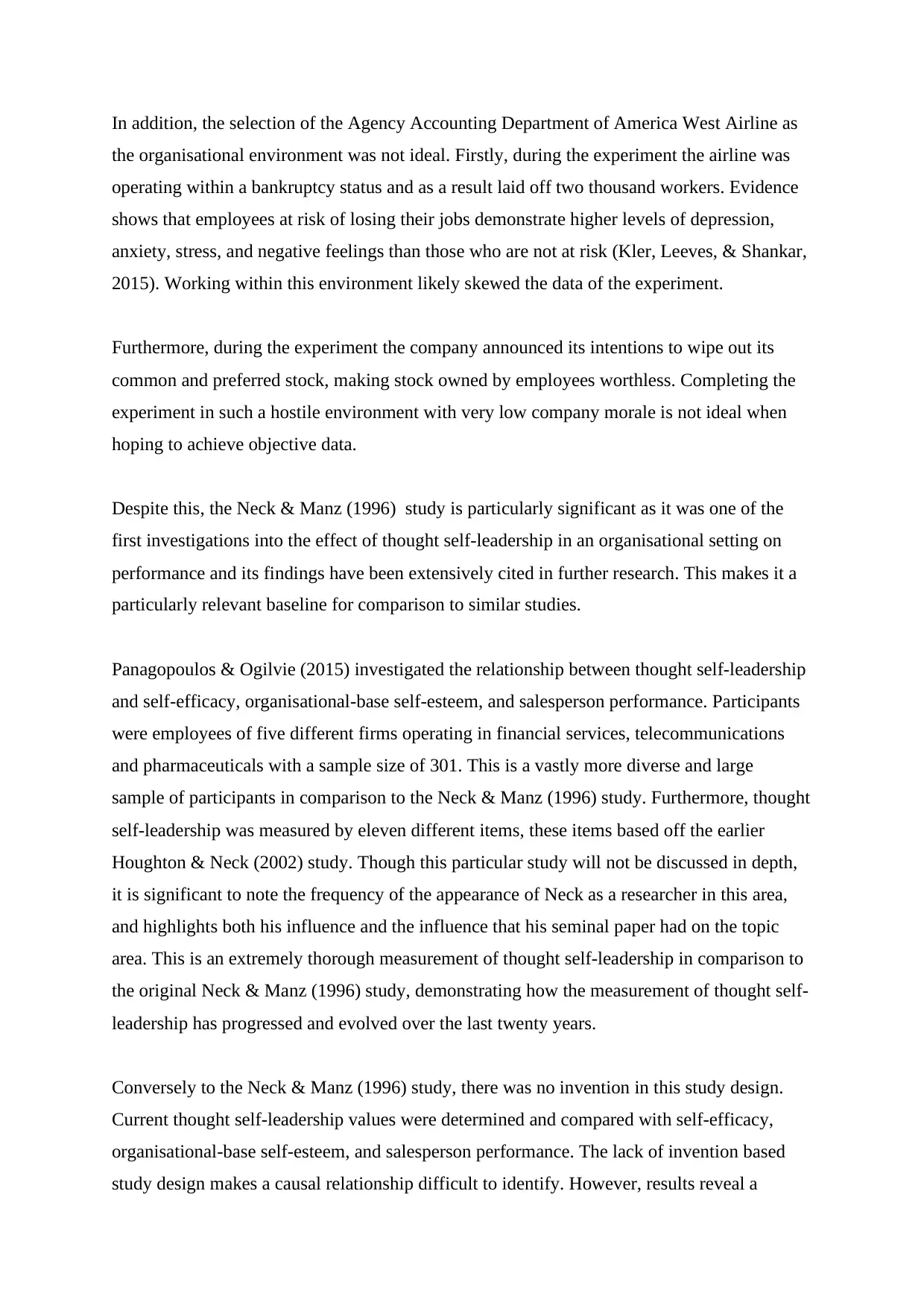
In addition, the selection of the Agency Accounting Department of America West Airline as
the organisational environment was not ideal. Firstly, during the experiment the airline was
operating within a bankruptcy status and as a result laid off two thousand workers. Evidence
shows that employees at risk of losing their jobs demonstrate higher levels of depression,
anxiety, stress, and negative feelings than those who are not at risk (Kler, Leeves, & Shankar,
2015). Working within this environment likely skewed the data of the experiment.
Furthermore, during the experiment the company announced its intentions to wipe out its
common and preferred stock, making stock owned by employees worthless. Completing the
experiment in such a hostile environment with very low company morale is not ideal when
hoping to achieve objective data.
Despite this, the Neck & Manz (1996) study is particularly significant as it was one of the
first investigations into the effect of thought self-leadership in an organisational setting on
performance and its findings have been extensively cited in further research. This makes it a
particularly relevant baseline for comparison to similar studies.
Panagopoulos & Ogilvie (2015) investigated the relationship between thought self-leadership
and self-efficacy, organisational-base self-esteem, and salesperson performance. Participants
were employees of five different firms operating in financial services, telecommunications
and pharmaceuticals with a sample size of 301. This is a vastly more diverse and large
sample of participants in comparison to the Neck & Manz (1996) study. Furthermore, thought
self-leadership was measured by eleven different items, these items based off the earlier
Houghton & Neck (2002) study. Though this particular study will not be discussed in depth,
it is significant to note the frequency of the appearance of Neck as a researcher in this area,
and highlights both his influence and the influence that his seminal paper had on the topic
area. This is an extremely thorough measurement of thought self-leadership in comparison to
the original Neck & Manz (1996) study, demonstrating how the measurement of thought self-
leadership has progressed and evolved over the last twenty years.
Conversely to the Neck & Manz (1996) study, there was no invention in this study design.
Current thought self-leadership values were determined and compared with self-efficacy,
organisational-base self-esteem, and salesperson performance. The lack of invention based
study design makes a causal relationship difficult to identify. However, results reveal a
the organisational environment was not ideal. Firstly, during the experiment the airline was
operating within a bankruptcy status and as a result laid off two thousand workers. Evidence
shows that employees at risk of losing their jobs demonstrate higher levels of depression,
anxiety, stress, and negative feelings than those who are not at risk (Kler, Leeves, & Shankar,
2015). Working within this environment likely skewed the data of the experiment.
Furthermore, during the experiment the company announced its intentions to wipe out its
common and preferred stock, making stock owned by employees worthless. Completing the
experiment in such a hostile environment with very low company morale is not ideal when
hoping to achieve objective data.
Despite this, the Neck & Manz (1996) study is particularly significant as it was one of the
first investigations into the effect of thought self-leadership in an organisational setting on
performance and its findings have been extensively cited in further research. This makes it a
particularly relevant baseline for comparison to similar studies.
Panagopoulos & Ogilvie (2015) investigated the relationship between thought self-leadership
and self-efficacy, organisational-base self-esteem, and salesperson performance. Participants
were employees of five different firms operating in financial services, telecommunications
and pharmaceuticals with a sample size of 301. This is a vastly more diverse and large
sample of participants in comparison to the Neck & Manz (1996) study. Furthermore, thought
self-leadership was measured by eleven different items, these items based off the earlier
Houghton & Neck (2002) study. Though this particular study will not be discussed in depth,
it is significant to note the frequency of the appearance of Neck as a researcher in this area,
and highlights both his influence and the influence that his seminal paper had on the topic
area. This is an extremely thorough measurement of thought self-leadership in comparison to
the original Neck & Manz (1996) study, demonstrating how the measurement of thought self-
leadership has progressed and evolved over the last twenty years.
Conversely to the Neck & Manz (1996) study, there was no invention in this study design.
Current thought self-leadership values were determined and compared with self-efficacy,
organisational-base self-esteem, and salesperson performance. The lack of invention based
study design makes a causal relationship difficult to identify. However, results reveal a
Paraphrase This Document
Need a fresh take? Get an instant paraphrase of this document with our AI Paraphraser
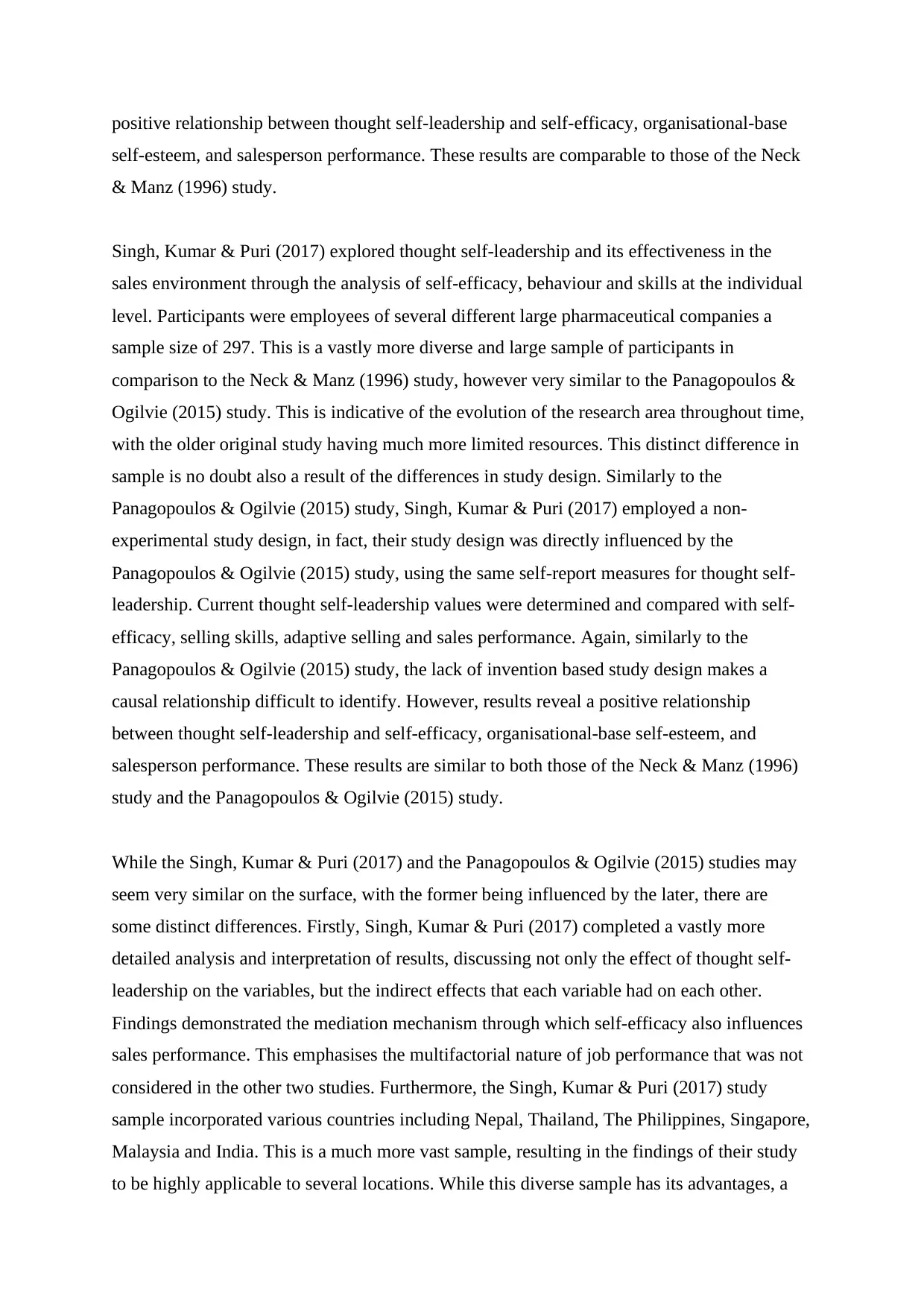
positive relationship between thought self-leadership and self-efficacy, organisational-base
self-esteem, and salesperson performance. These results are comparable to those of the Neck
& Manz (1996) study.
Singh, Kumar & Puri (2017) explored thought self-leadership and its effectiveness in the
sales environment through the analysis of self-efficacy, behaviour and skills at the individual
level. Participants were employees of several different large pharmaceutical companies a
sample size of 297. This is a vastly more diverse and large sample of participants in
comparison to the Neck & Manz (1996) study, however very similar to the Panagopoulos &
Ogilvie (2015) study. This is indicative of the evolution of the research area throughout time,
with the older original study having much more limited resources. This distinct difference in
sample is no doubt also a result of the differences in study design. Similarly to the
Panagopoulos & Ogilvie (2015) study, Singh, Kumar & Puri (2017) employed a non-
experimental study design, in fact, their study design was directly influenced by the
Panagopoulos & Ogilvie (2015) study, using the same self-report measures for thought self-
leadership. Current thought self-leadership values were determined and compared with self-
efficacy, selling skills, adaptive selling and sales performance. Again, similarly to the
Panagopoulos & Ogilvie (2015) study, the lack of invention based study design makes a
causal relationship difficult to identify. However, results reveal a positive relationship
between thought self-leadership and self-efficacy, organisational-base self-esteem, and
salesperson performance. These results are similar to both those of the Neck & Manz (1996)
study and the Panagopoulos & Ogilvie (2015) study.
While the Singh, Kumar & Puri (2017) and the Panagopoulos & Ogilvie (2015) studies may
seem very similar on the surface, with the former being influenced by the later, there are
some distinct differences. Firstly, Singh, Kumar & Puri (2017) completed a vastly more
detailed analysis and interpretation of results, discussing not only the effect of thought self-
leadership on the variables, but the indirect effects that each variable had on each other.
Findings demonstrated the mediation mechanism through which self-efficacy also influences
sales performance. This emphasises the multifactorial nature of job performance that was not
considered in the other two studies. Furthermore, the Singh, Kumar & Puri (2017) study
sample incorporated various countries including Nepal, Thailand, The Philippines, Singapore,
Malaysia and India. This is a much more vast sample, resulting in the findings of their study
to be highly applicable to several locations. While this diverse sample has its advantages, a
self-esteem, and salesperson performance. These results are comparable to those of the Neck
& Manz (1996) study.
Singh, Kumar & Puri (2017) explored thought self-leadership and its effectiveness in the
sales environment through the analysis of self-efficacy, behaviour and skills at the individual
level. Participants were employees of several different large pharmaceutical companies a
sample size of 297. This is a vastly more diverse and large sample of participants in
comparison to the Neck & Manz (1996) study, however very similar to the Panagopoulos &
Ogilvie (2015) study. This is indicative of the evolution of the research area throughout time,
with the older original study having much more limited resources. This distinct difference in
sample is no doubt also a result of the differences in study design. Similarly to the
Panagopoulos & Ogilvie (2015) study, Singh, Kumar & Puri (2017) employed a non-
experimental study design, in fact, their study design was directly influenced by the
Panagopoulos & Ogilvie (2015) study, using the same self-report measures for thought self-
leadership. Current thought self-leadership values were determined and compared with self-
efficacy, selling skills, adaptive selling and sales performance. Again, similarly to the
Panagopoulos & Ogilvie (2015) study, the lack of invention based study design makes a
causal relationship difficult to identify. However, results reveal a positive relationship
between thought self-leadership and self-efficacy, organisational-base self-esteem, and
salesperson performance. These results are similar to both those of the Neck & Manz (1996)
study and the Panagopoulos & Ogilvie (2015) study.
While the Singh, Kumar & Puri (2017) and the Panagopoulos & Ogilvie (2015) studies may
seem very similar on the surface, with the former being influenced by the later, there are
some distinct differences. Firstly, Singh, Kumar & Puri (2017) completed a vastly more
detailed analysis and interpretation of results, discussing not only the effect of thought self-
leadership on the variables, but the indirect effects that each variable had on each other.
Findings demonstrated the mediation mechanism through which self-efficacy also influences
sales performance. This emphasises the multifactorial nature of job performance that was not
considered in the other two studies. Furthermore, the Singh, Kumar & Puri (2017) study
sample incorporated various countries including Nepal, Thailand, The Philippines, Singapore,
Malaysia and India. This is a much more vast sample, resulting in the findings of their study
to be highly applicable to several locations. While this diverse sample has its advantages, a
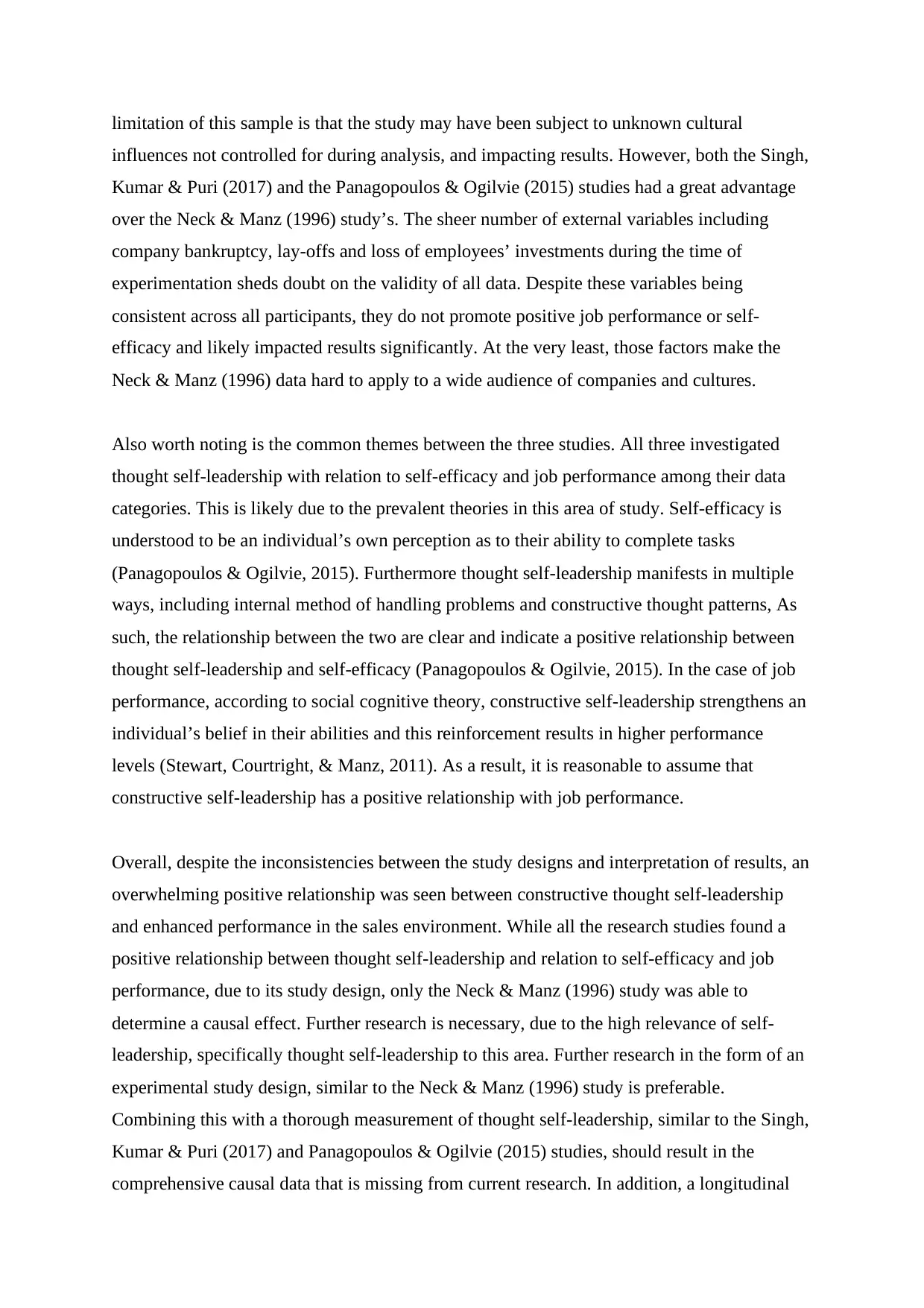
limitation of this sample is that the study may have been subject to unknown cultural
influences not controlled for during analysis, and impacting results. However, both the Singh,
Kumar & Puri (2017) and the Panagopoulos & Ogilvie (2015) studies had a great advantage
over the Neck & Manz (1996) study’s. The sheer number of external variables including
company bankruptcy, lay-offs and loss of employees’ investments during the time of
experimentation sheds doubt on the validity of all data. Despite these variables being
consistent across all participants, they do not promote positive job performance or self-
efficacy and likely impacted results significantly. At the very least, those factors make the
Neck & Manz (1996) data hard to apply to a wide audience of companies and cultures.
Also worth noting is the common themes between the three studies. All three investigated
thought self-leadership with relation to self-efficacy and job performance among their data
categories. This is likely due to the prevalent theories in this area of study. Self-efficacy is
understood to be an individual’s own perception as to their ability to complete tasks
(Panagopoulos & Ogilvie, 2015). Furthermore thought self-leadership manifests in multiple
ways, including internal method of handling problems and constructive thought patterns, As
such, the relationship between the two are clear and indicate a positive relationship between
thought self-leadership and self-efficacy (Panagopoulos & Ogilvie, 2015). In the case of job
performance, according to social cognitive theory, constructive self-leadership strengthens an
individual’s belief in their abilities and this reinforcement results in higher performance
levels (Stewart, Courtright, & Manz, 2011). As a result, it is reasonable to assume that
constructive self-leadership has a positive relationship with job performance.
Overall, despite the inconsistencies between the study designs and interpretation of results, an
overwhelming positive relationship was seen between constructive thought self-leadership
and enhanced performance in the sales environment. While all the research studies found a
positive relationship between thought self-leadership and relation to self-efficacy and job
performance, due to its study design, only the Neck & Manz (1996) study was able to
determine a causal effect. Further research is necessary, due to the high relevance of self-
leadership, specifically thought self-leadership to this area. Further research in the form of an
experimental study design, similar to the Neck & Manz (1996) study is preferable.
Combining this with a thorough measurement of thought self-leadership, similar to the Singh,
Kumar & Puri (2017) and Panagopoulos & Ogilvie (2015) studies, should result in the
comprehensive causal data that is missing from current research. In addition, a longitudinal
influences not controlled for during analysis, and impacting results. However, both the Singh,
Kumar & Puri (2017) and the Panagopoulos & Ogilvie (2015) studies had a great advantage
over the Neck & Manz (1996) study’s. The sheer number of external variables including
company bankruptcy, lay-offs and loss of employees’ investments during the time of
experimentation sheds doubt on the validity of all data. Despite these variables being
consistent across all participants, they do not promote positive job performance or self-
efficacy and likely impacted results significantly. At the very least, those factors make the
Neck & Manz (1996) data hard to apply to a wide audience of companies and cultures.
Also worth noting is the common themes between the three studies. All three investigated
thought self-leadership with relation to self-efficacy and job performance among their data
categories. This is likely due to the prevalent theories in this area of study. Self-efficacy is
understood to be an individual’s own perception as to their ability to complete tasks
(Panagopoulos & Ogilvie, 2015). Furthermore thought self-leadership manifests in multiple
ways, including internal method of handling problems and constructive thought patterns, As
such, the relationship between the two are clear and indicate a positive relationship between
thought self-leadership and self-efficacy (Panagopoulos & Ogilvie, 2015). In the case of job
performance, according to social cognitive theory, constructive self-leadership strengthens an
individual’s belief in their abilities and this reinforcement results in higher performance
levels (Stewart, Courtright, & Manz, 2011). As a result, it is reasonable to assume that
constructive self-leadership has a positive relationship with job performance.
Overall, despite the inconsistencies between the study designs and interpretation of results, an
overwhelming positive relationship was seen between constructive thought self-leadership
and enhanced performance in the sales environment. While all the research studies found a
positive relationship between thought self-leadership and relation to self-efficacy and job
performance, due to its study design, only the Neck & Manz (1996) study was able to
determine a causal effect. Further research is necessary, due to the high relevance of self-
leadership, specifically thought self-leadership to this area. Further research in the form of an
experimental study design, similar to the Neck & Manz (1996) study is preferable.
Combining this with a thorough measurement of thought self-leadership, similar to the Singh,
Kumar & Puri (2017) and Panagopoulos & Ogilvie (2015) studies, should result in the
comprehensive causal data that is missing from current research. In addition, a longitudinal
⊘ This is a preview!⊘
Do you want full access?
Subscribe today to unlock all pages.

Trusted by 1+ million students worldwide
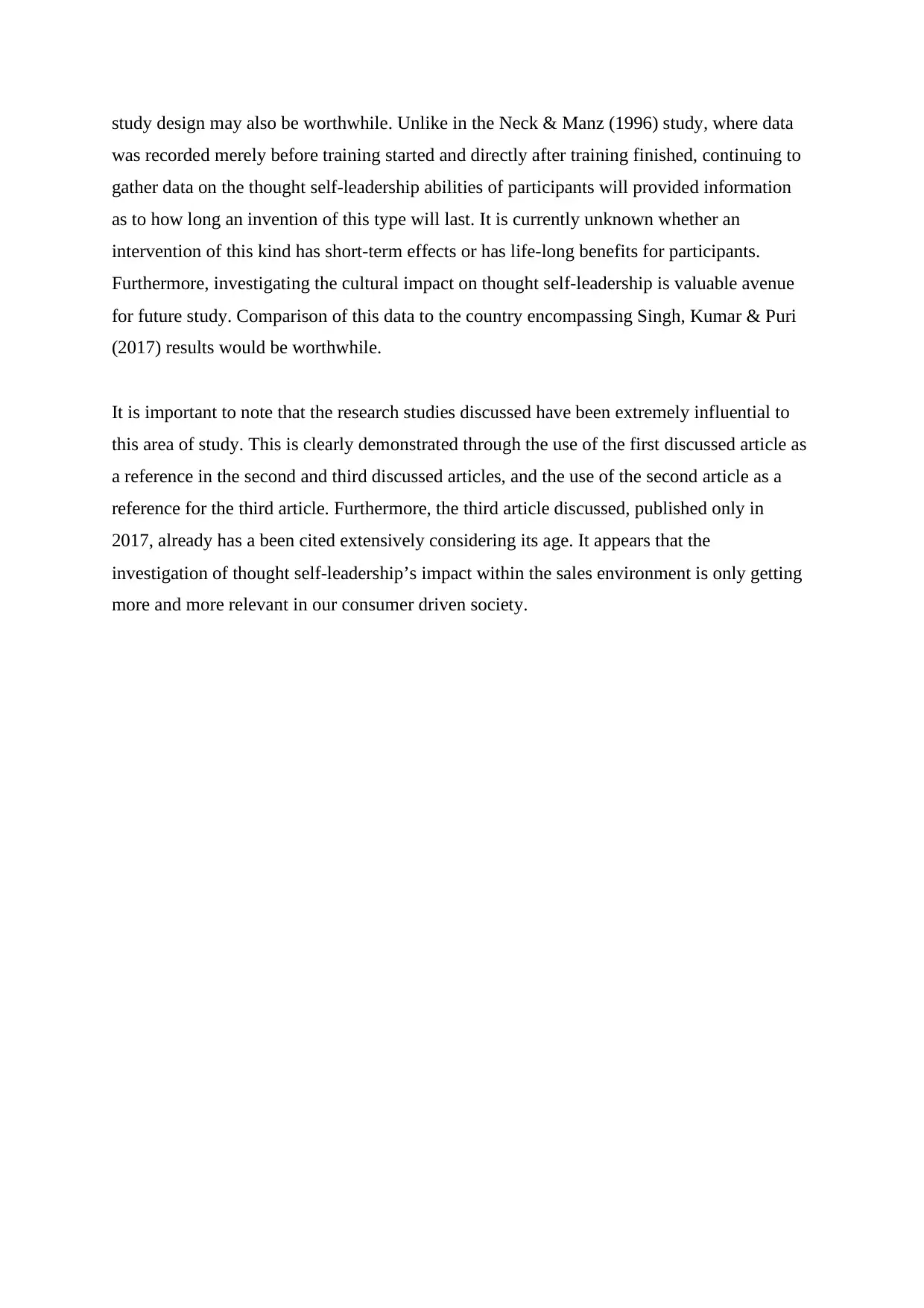
study design may also be worthwhile. Unlike in the Neck & Manz (1996) study, where data
was recorded merely before training started and directly after training finished, continuing to
gather data on the thought self-leadership abilities of participants will provided information
as to how long an invention of this type will last. It is currently unknown whether an
intervention of this kind has short-term effects or has life-long benefits for participants.
Furthermore, investigating the cultural impact on thought self-leadership is valuable avenue
for future study. Comparison of this data to the country encompassing Singh, Kumar & Puri
(2017) results would be worthwhile.
It is important to note that the research studies discussed have been extremely influential to
this area of study. This is clearly demonstrated through the use of the first discussed article as
a reference in the second and third discussed articles, and the use of the second article as a
reference for the third article. Furthermore, the third article discussed, published only in
2017, already has a been cited extensively considering its age. It appears that the
investigation of thought self-leadership’s impact within the sales environment is only getting
more and more relevant in our consumer driven society.
was recorded merely before training started and directly after training finished, continuing to
gather data on the thought self-leadership abilities of participants will provided information
as to how long an invention of this type will last. It is currently unknown whether an
intervention of this kind has short-term effects or has life-long benefits for participants.
Furthermore, investigating the cultural impact on thought self-leadership is valuable avenue
for future study. Comparison of this data to the country encompassing Singh, Kumar & Puri
(2017) results would be worthwhile.
It is important to note that the research studies discussed have been extremely influential to
this area of study. This is clearly demonstrated through the use of the first discussed article as
a reference in the second and third discussed articles, and the use of the second article as a
reference for the third article. Furthermore, the third article discussed, published only in
2017, already has a been cited extensively considering its age. It appears that the
investigation of thought self-leadership’s impact within the sales environment is only getting
more and more relevant in our consumer driven society.
Paraphrase This Document
Need a fresh take? Get an instant paraphrase of this document with our AI Paraphraser
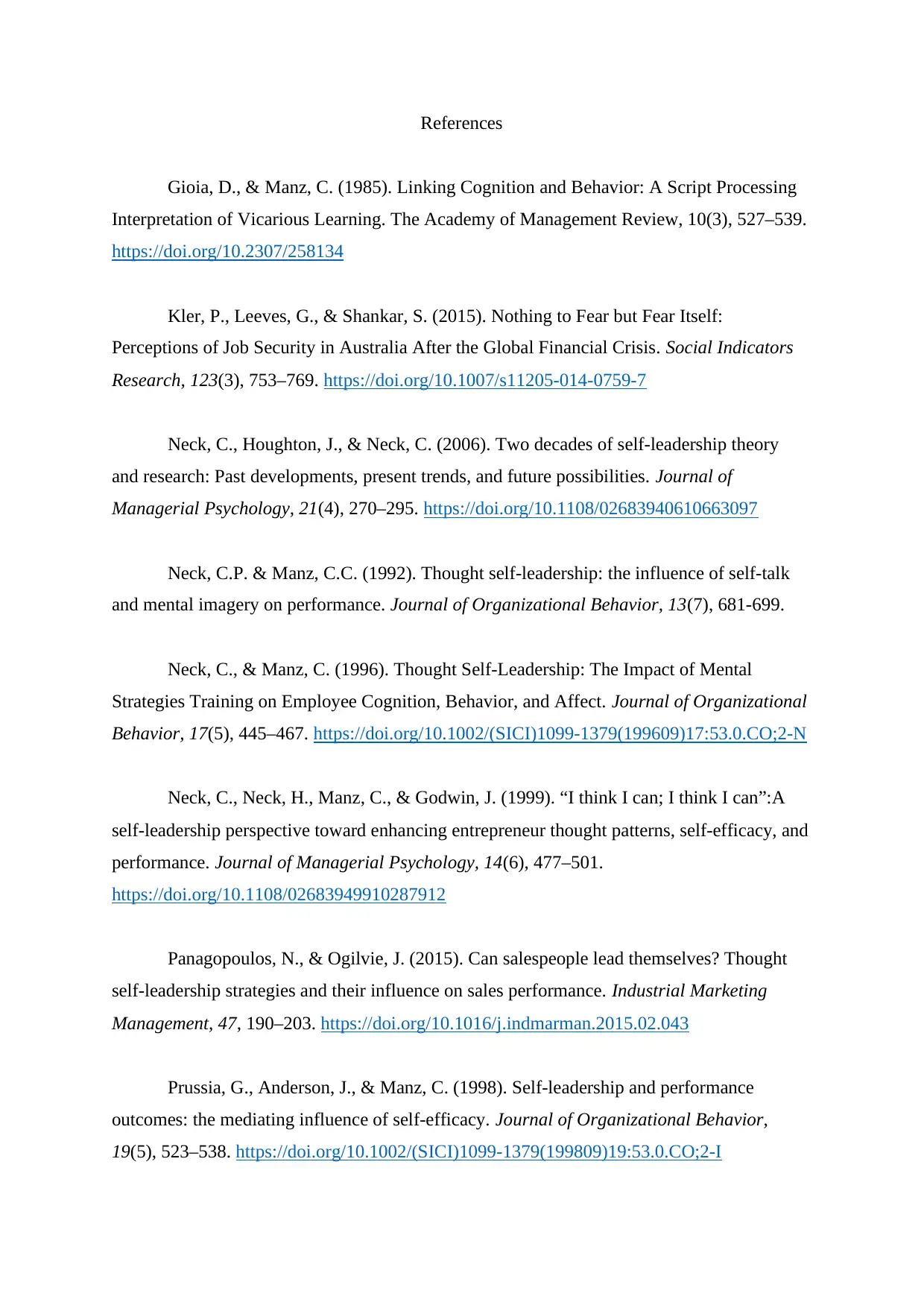
References
Gioia, D., & Manz, C. (1985). Linking Cognition and Behavior: A Script Processing
Interpretation of Vicarious Learning. The Academy of Management Review, 10(3), 527–539.
https://doi.org/10.2307/258134
Kler, P., Leeves, G., & Shankar, S. (2015). Nothing to Fear but Fear Itself:
Perceptions of Job Security in Australia After the Global Financial Crisis. Social Indicators
Research, 123(3), 753–769. https://doi.org/10.1007/s11205-014-0759-7
Neck, C., Houghton, J., & Neck, C. (2006). Two decades of self-leadership theory
and research: Past developments, present trends, and future possibilities. Journal of
Managerial Psychology, 21(4), 270–295. https://doi.org/10.1108/02683940610663097
Neck, C.P. & Manz, C.C. (1992). Thought self-leadership: the influence of self-talk
and mental imagery on performance. Journal of Organizational Behavior, 13(7), 681-699.
Neck, C., & Manz, C. (1996). Thought Self-Leadership: The Impact of Mental
Strategies Training on Employee Cognition, Behavior, and Affect. Journal of Organizational
Behavior, 17(5), 445–467. https://doi.org/10.1002/(SICI)1099-1379(199609)17:53.0.CO;2-N
Neck, C., Neck, H., Manz, C., & Godwin, J. (1999). “I think I can; I think I can”:A
self-leadership perspective toward enhancing entrepreneur thought patterns, self-efficacy, and
performance. Journal of Managerial Psychology, 14(6), 477–501.
https://doi.org/10.1108/02683949910287912
Panagopoulos, N., & Ogilvie, J. (2015). Can salespeople lead themselves? Thought
self-leadership strategies and their influence on sales performance. Industrial Marketing
Management, 47, 190–203. https://doi.org/10.1016/j.indmarman.2015.02.043
Prussia, G., Anderson, J., & Manz, C. (1998). Self‐leadership and performance
outcomes: the mediating influence of self‐efficacy. Journal of Organizational Behavior,
19(5), 523–538. https://doi.org/10.1002/(SICI)1099-1379(199809)19:53.0.CO;2-I
Gioia, D., & Manz, C. (1985). Linking Cognition and Behavior: A Script Processing
Interpretation of Vicarious Learning. The Academy of Management Review, 10(3), 527–539.
https://doi.org/10.2307/258134
Kler, P., Leeves, G., & Shankar, S. (2015). Nothing to Fear but Fear Itself:
Perceptions of Job Security in Australia After the Global Financial Crisis. Social Indicators
Research, 123(3), 753–769. https://doi.org/10.1007/s11205-014-0759-7
Neck, C., Houghton, J., & Neck, C. (2006). Two decades of self-leadership theory
and research: Past developments, present trends, and future possibilities. Journal of
Managerial Psychology, 21(4), 270–295. https://doi.org/10.1108/02683940610663097
Neck, C.P. & Manz, C.C. (1992). Thought self-leadership: the influence of self-talk
and mental imagery on performance. Journal of Organizational Behavior, 13(7), 681-699.
Neck, C., & Manz, C. (1996). Thought Self-Leadership: The Impact of Mental
Strategies Training on Employee Cognition, Behavior, and Affect. Journal of Organizational
Behavior, 17(5), 445–467. https://doi.org/10.1002/(SICI)1099-1379(199609)17:53.0.CO;2-N
Neck, C., Neck, H., Manz, C., & Godwin, J. (1999). “I think I can; I think I can”:A
self-leadership perspective toward enhancing entrepreneur thought patterns, self-efficacy, and
performance. Journal of Managerial Psychology, 14(6), 477–501.
https://doi.org/10.1108/02683949910287912
Panagopoulos, N., & Ogilvie, J. (2015). Can salespeople lead themselves? Thought
self-leadership strategies and their influence on sales performance. Industrial Marketing
Management, 47, 190–203. https://doi.org/10.1016/j.indmarman.2015.02.043
Prussia, G., Anderson, J., & Manz, C. (1998). Self‐leadership and performance
outcomes: the mediating influence of self‐efficacy. Journal of Organizational Behavior,
19(5), 523–538. https://doi.org/10.1002/(SICI)1099-1379(199809)19:53.0.CO;2-I
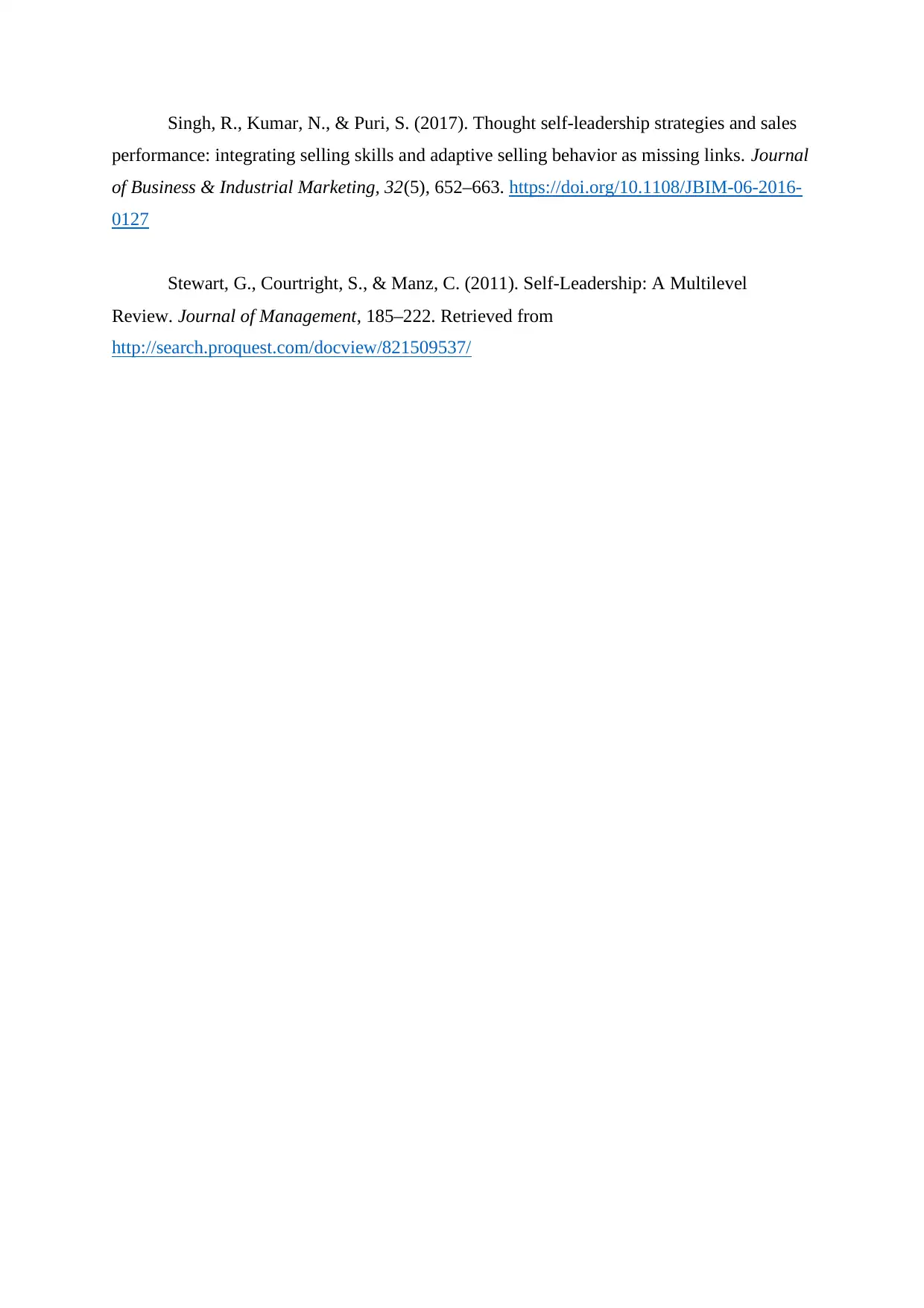
Singh, R., Kumar, N., & Puri, S. (2017). Thought self-leadership strategies and sales
performance: integrating selling skills and adaptive selling behavior as missing links. Journal
of Business & Industrial Marketing, 32(5), 652–663. https://doi.org/10.1108/JBIM-06-2016-
0127
Stewart, G., Courtright, S., & Manz, C. (2011). Self-Leadership: A Multilevel
Review. Journal of Management, 185–222. Retrieved from
http://search.proquest.com/docview/821509537/
performance: integrating selling skills and adaptive selling behavior as missing links. Journal
of Business & Industrial Marketing, 32(5), 652–663. https://doi.org/10.1108/JBIM-06-2016-
0127
Stewart, G., Courtright, S., & Manz, C. (2011). Self-Leadership: A Multilevel
Review. Journal of Management, 185–222. Retrieved from
http://search.proquest.com/docview/821509537/
⊘ This is a preview!⊘
Do you want full access?
Subscribe today to unlock all pages.

Trusted by 1+ million students worldwide
1 out of 9
Related Documents
Your All-in-One AI-Powered Toolkit for Academic Success.
+13062052269
info@desklib.com
Available 24*7 on WhatsApp / Email
![[object Object]](/_next/static/media/star-bottom.7253800d.svg)
Unlock your academic potential
Copyright © 2020–2025 A2Z Services. All Rights Reserved. Developed and managed by ZUCOL.


